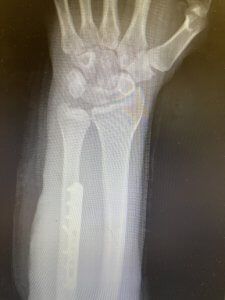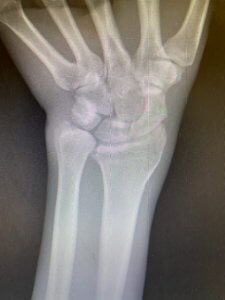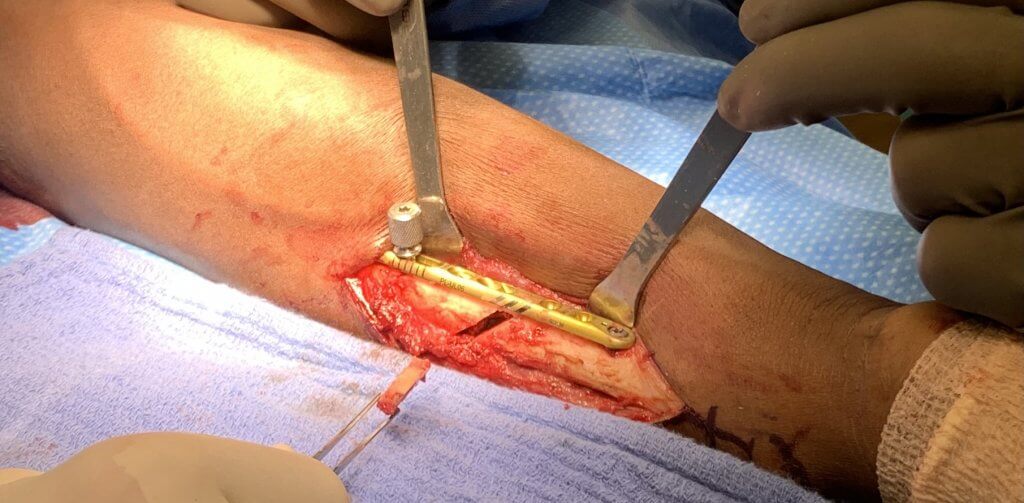Ulnar Impaction Syndrome (UIS)
When the ulna length increases compared to the radius length, it results in a greater transmission of force across the triangular fibrocartilage complex (TFCC). This cartilage structure, which is located on the small finger side of the wrist, provides stability for the radius and ulna when rotating the forearm or gripping objects. The TFCC is also responsible for protecting the carpal bones in the wrist.

 The ulnocarpal joint typically absorbs around 18% of the wrist’s total load, where the wrist is considered neutral. The rest of the load is taken by the radiocarpal joint in most cases. When there is a positive variance, the ulnocarpal load shifts to 40%, with an increase of up to 65% observed in patients who have suffered a radius injury in the past. When the ulna increases in length, a thinning of the articular disc is not unusual. This can lead to a greater risk of TFCC wear and tear, including possible perforation.
The ulnocarpal joint typically absorbs around 18% of the wrist’s total load, where the wrist is considered neutral. The rest of the load is taken by the radiocarpal joint in most cases. When there is a positive variance, the ulnocarpal load shifts to 40%, with an increase of up to 65% observed in patients who have suffered a radius injury in the past. When the ulna increases in length, a thinning of the articular disc is not unusual. This can lead to a greater risk of TFCC wear and tear, including possible perforation.
Positive ulnar variance is the most common cause of UIS. However, the condition can also present in ulnar neutral or negative ulnar variance. Axial loading and rotation are actions associated mainly with athletic activities, which is why athletes are more prone to developing UIS when the upper limbs feature heavily in their chosen discipline.
What is Ulnar Impaction Syndrome?
Ulnar impaction syndrome occurs when the ulna is relatively larger than it should be when compared to the radius. This forces the ulna to bear more of the weight and force to the wrist on that side of the arm. UIS is most commonly a congenital condition but can also result from the shortening of the radius from an injury. Symptoms of UIS typically do not emerge until the affected individual is older, regardless of the initial cause. This is due to the degeneration of supportive tissues and structures, including ligaments and cartilage.
UIS symptoms can vary depending on the severity of the condition, other health conditions and the lifestyle of the patient. Pain, when rotating the wrist or forearm, that only eases with rest, is a common symptom. When rotating the hand to face up or down, the patient may experience a painful clicking or locking sensation. Although rare as a symptom of UIS, swelling may occur in the wrist or forearm. Range or rotation and motion are also impacted to various degrees when a patient suffers from ulnar impaction syndrome.
UIS Diagnosis & Treatment Options
A manual examination that includes palpation, range of motion and strength measurement is primarily used to determine the likelihood of ulnar impaction syndrome. However, a radiograph or MRI is a more conclusive means of diagnosing the condition. At Ortho Sport & Spine Physicians, we also ask about medical history and sporting activities in which the patient is engaged. Determining the cause of UIS is important, and the treatment approach can depend on current lifestyle or work commitments. This is especially the case for athletes who wish to return to a sport after treatment and recovery.

Ideally, treatment using conservative methods such as immobilization and medications is preferable to surgery. For athletes, this approach is not usually practical due to continued involvement in the sporting activity that caused or exacerbated the condition. Where conservative treatment does not work, surgical options are recommended. Traditionally, surgery required the insertion of two large screws that cross at the wrist. However, Dr. Langer of Ortho Sport & Spine Physicians can eliminate the need for this intrusive procedure with a less intrusive treatment approach.
Early treatment of this condition results in better outcomes for athletes. If you are experiencing UIS symptoms, book a consultation with Dr. Langer at his Ortho Sport & Spine Physicians office.

